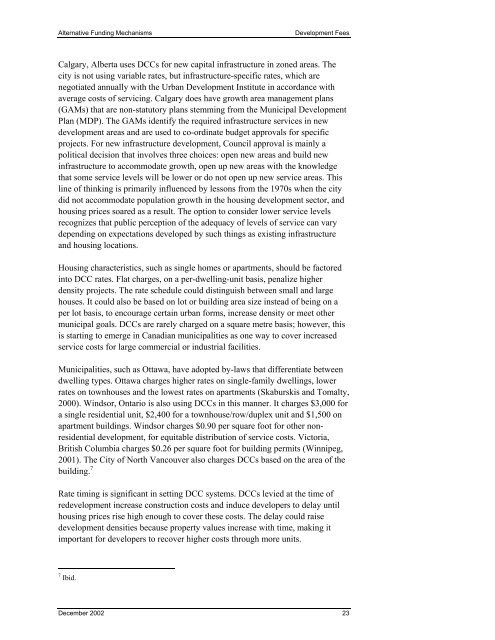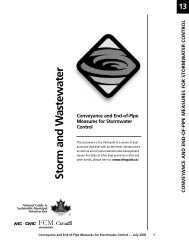ALTERNATIVE FUNDING MECHANISMS - FCM
ALTERNATIVE FUNDING MECHANISMS - FCM
ALTERNATIVE FUNDING MECHANISMS - FCM
You also want an ePaper? Increase the reach of your titles
YUMPU automatically turns print PDFs into web optimized ePapers that Google loves.
Alternative Funding Mechanisms Development Fees<br />
Calgary, Alberta uses DCCs for new capital infrastructure in zoned areas. The<br />
city is not using variable rates, but infrastructure-specific rates, which are<br />
negotiated annually with the Urban Development Institute in accordance with<br />
average costs of servicing. Calgary does have growth area management plans<br />
(GAMs) that are non-statutory plans stemming from the Municipal Development<br />
Plan (MDP). The GAMs identify the required infrastructure services in new<br />
development areas and are used to co-ordinate budget approvals for specific<br />
projects. For new infrastructure development, Council approval is mainly a<br />
political decision that involves three choices: open new areas and build new<br />
infrastructure to accommodate growth, open up new areas with the knowledge<br />
that some service levels will be lower or do not open up new service areas. This<br />
line of thinking is primarily influenced by lessons from the 1970s when the city<br />
did not accommodate population growth in the housing development sector, and<br />
housing prices soared as a result. The option to consider lower service levels<br />
recognizes that public perception of the adequacy of levels of service can vary<br />
depending on expectations developed by such things as existing infrastructure<br />
and housing locations.<br />
Housing characteristics, such as single homes or apartments, should be factored<br />
into DCC rates. Flat charges, on a per-dwelling-unit basis, penalize higher<br />
density projects. The rate schedule could distinguish between small and large<br />
houses. It could also be based on lot or building area size instead of being on a<br />
per lot basis, to encourage certain urban forms, increase density or meet other<br />
municipal goals. DCCs are rarely charged on a square metre basis; however, this<br />
is starting to emerge in Canadian municipalities as one way to cover increased<br />
service costs for large commercial or industrial facilities.<br />
Municipalities, such as Ottawa, have adopted by-laws that differentiate between<br />
dwelling types. Ottawa charges higher rates on single-family dwellings, lower<br />
rates on townhouses and the lowest rates on apartments (Skaburskis and Tomalty,<br />
2000). Windsor, Ontario is also using DCCs in this manner. It charges $3,000 for<br />
a single residential unit, $2,400 for a townhouse/row/duplex unit and $1,500 on<br />
apartment buildings. Windsor charges $0.90 per square foot for other nonresidential<br />
development, for equitable distribution of service costs. Victoria,<br />
British Columbia charges $0.26 per square foot for building permits (Winnipeg,<br />
2001). The City of North Vancouver also charges DCCs based on the area of the<br />
building. 7<br />
Rate timing is significant in setting DCC systems. DCCs levied at the time of<br />
redevelopment increase construction costs and induce developers to delay until<br />
housing prices rise high enough to cover these costs. The delay could raise<br />
development densities because property values increase with time, making it<br />
important for developers to recover higher costs through more units.<br />
7 Ibid.<br />
December 2002 23
















